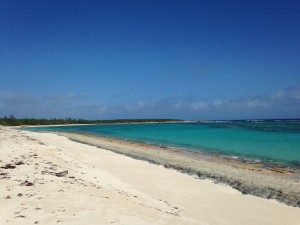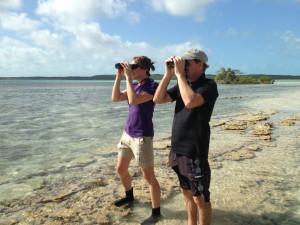Bahamas Piping Plover Project
Eleuthera Edition
By Todd Pover, Beach Nesting Bird Project Manager
Stephanie Egger, Wildlife Biologist

Up until now, nearly all of our piping plover conservation work in the Bahamas has been focused on the island of Abaco. One of the objectives of our Disney Worldwide Conservation Fund grant is to identify other islands and partners where and with whom the model we are developing on Abaco might be implemented as well. With this in mind, we spent the past several days on the island of Eleuthera.
Although we believe the basic elements of our Abaco work are transferable to other islands, a “one size fits all” approach may not entirely work. The various major islands are unified under the Bahamas flag, but each also has its own flavor, history, and way of life. The best analogy would be that they operate much like the individual states in the U.S.
On Abaco, we have been partnering with Friends of the Environment, a non-profit organization with a strong education and outreach component to all of their work – not so different from what we do here at the Conserve Wildlife Foundation. On Eleuthera we are hoping to partner with the Cape Eleuthera Institute (CEI) and The Island School. Although education is at the core of their work as well, it is also different in that they carry out and support primary research and host visiting scientists and students at their campus.
It has been a long and winding road that finally landed us at CEI, but an important part of the story is that they have some New Jersey connections. One of our long-time conservation partners here on the plover breeding grounds is Dr. John Tiedemann, an assistant dean/professor at Monmouth University. He has been bringing students down to CEI for a Tropical Island Ecology class for some time and serves on their Advisory Board – we owe many thanks to John for facilitating our visit!

One thing that many scientists and conservationists are focusing on here in the Bahamas, including CEI, is shallow water and tidal flat research. This is a key habitat for many marine species, but also serves as a critical foraging location for shorebirds, such as piping plovers. CEI and The Island School have an especially strong marine and aquatic research program – now we are hoping they may be interested in avian or shorebird research as well.
Although very short, our visit to CEI was a crazy whirlwind adventure…and very productive. We arrived on Tuesday afternoon after three flights and quickly familiarized ourselves with the campus layout and staff. The next morning John took us to a couple of beaches and sounds he felt might provide suitable piping plover habitat, including one where he had just seen his first Bahamas plovers the previous day. This trip was really more about partner building and orienting ourselves to Eleuthera, so it was a bonus to actually see a few piping plovers – they “cooperated” by being in the exact same location they had been seen by John the day before. Site fidelity is a wonderful thing!

In the afternoon, we joined up with John’s students, who were assisting with a bonefish research project. They had spent most of the day setting up nets across a mangrove creek in hopes of catching the bonefish as they moved out of the creek with the outgoing tide. We arrived just in time for the capture and then tagging of bonefish. What a thrill to finally see the famed bonefish and get an up-close glimpse of some of the other research going on in the Bahamas. It was especially nice to be looking at what is in the water that is all around us during our plover surveys here in the Bahamas, instead of having binos attached to our face all day.
Next was the long slog back out of the winding creek and time to help get the equipment stowed away. After a quick shower and dinner on campus, it was our turn to be the “guests of honor.” We presented an hour long evening program on our piping plover research project to a very receptive group of about 75 staff, researchers, and students at CEI. They threw a nice reception afterwards for all the visiting and resident staff and researchers, so we had an opportunity to continue our networking and plover “promotion” well into the night.
Unfortunately, we had to leave early in the morning the next day, but we left feeling very excited about this potential new chapter in our Bahamas piping plover research. We were extremely impressed with the staff, facilities, and mission at CEI and The Island School! We are optimistic there will be an opportunity for collaboration moving forward.
Discover more from Conserve Wildlife Foundation of NJ
Subscribe to get the latest posts sent to your email.